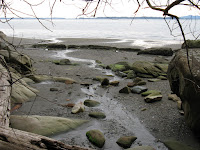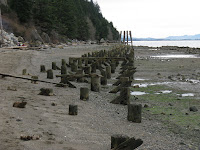skip to main |
skip to sidebar





What better location for a Canadian-U.S. workshop on sea level rise than a large resort built on the tip of a spit within a stone's throw of the international border and within a meter of high water.
Semiahmoo Spit is located at the distal end of a drift cell that begins about 5 miles south near Birch Point. For thousands of years, sand and gravel has traveled north, traversing the mouth of Drayton Harbor on this slender strip of land, and then disappeared under the bar. Seriously, the beach just sort of runs under Packers Lounge, then shows up on the other side as the slightly mellower beaches of Tongue Point (next post) at the tip of the spit. Packer's would be an appropriate location for some future meeting of coastal geomorphologists - the bar at the end of the beach.
The distal portion of Semiahmoo is large, particularly when compared to the narrow neck of the spit that you have to cross to get to it (see the aerial - click on the title of the post). Most of this land was built up with fill (dredged from the channel and the marina, I assume), so it has a couple foot headstart on anthropocene sea levels -- though it will become increasingly hard to get here, or to get away from here, during the big storms that will toss gravel and logs over the access road. Fortunately, most of the development on the spit has been kept away from the shoreline and except for the riprap that protects the neck, the beach is in good shape - except that in some places it is backed by an unnatural eroding bank of fill.


Onamac is one of several similar landforms along the west shore of Camano Island - and such a common type on Puget Sound that I suppose we really need a better name for them. Or a name at all. I might call it an assymetric looped barrier (in private) (title of post links to an aerial view). It's hard to call it a cuspate foreland, or a recurved spit, because those don't quite fit (though they are close) and the more generic names like accretion beach, depositional shoreform, constructional landform, or low point are too broad. We were visiting this private site last week because it's a dead ringer for Kayak Point, a few miles east on the eastern shore of Port Susan. And we needed an analog to explain to the Parks folks the rationale for proposed improvements at Kayak Point.
The high bluff north of Onamac is an impressive perch for a bunch of big homes with outstanding views and an abrupt edge to their lawn. This is also the only place I am aware of on the Sound where we have good evidence for a large landslide that involved both the bluff and the submarine slope. This huge headscarp is matched by an enormous slide block on the bottom of Saratoga Passage (see Whitaker's UW senior thesis). Must have been an exciting ride - and maybe a big splash, too. With better coastal bathymetry, maybe we could identify more of these things.



In previous years, we've brought this class to Kala Point, but this year we shifted things around and headed to Marrowstone Island and Fort Flagler instead. Marrowstone Point is a cuspate foreland at the northeastern tip of the island, fed by sediment from the eastern shore of the island and a short stretch of bluffs on the north. The north side has been turned into a dike and armored with riprap, the better to protect the point from whatever it is that it didn't need protection from for the previous two thousand years (and pretty much eliminating the high tide beach and the backshore). Right at the base of the point, where the bluff starts to rise, there's a big glacial boulder eroding out of the till, along with an old military pillbox or something of that sort. Someting to measure future erosion against.
The bluffs northwest of the point have been impressively collapsing for the last three years, dumping sandy sediment onto the beach (the pictures of the bluffs this trip were really dark, but there's a nice slightly outdated one at Fort Flagler, May, 2006) . I don't know of another 1/4 mile stretch of shoreline in the Sound where this much erosion has happened so quickly. Locals report a significant loss of kelp, which the heavy sediment loading might help explain, but the kelp started disappearing long before this recent episode of mass-wasting and has been disappearing in other places where erosion isn't a clear culprit. There's so much that we don't understand about this system!


Of the class of 40 or so people here to learn about climate change, only half a dozen or so probably wandered down the 200 yards to the overlook at the bluff. The classroom at the Reserve is nice, but the shore is always better. The tide was out, exposing not just the narrow gravelly beach, but miles of tidal flats and matted eelgrass waiting to be floated by the next tide.
A couple interesting things illustrated by the photos. If you look carefully, you can see a gravelly fan extending out across the flats - this is typical wherever a small stream reaches the beach along here and at lower tides spreads the sand and gravel seaward. The tree shows how you can use vegetation (big straight-growing conifers, at least) to infer the history of bank stability. This tree suggests two episodes of instability - one, many decades ago, when a young tree collapsed and a branch took over vertical growth, and then a more recent event that caused the vertical trunk to tilt landwards as the roots slid. Or something like that.

 I probably should have titled this post "Capitol Lake," just to avoid controversy, but after all, it is the mouth of the Deschutes River and it would be an estuary were it not for the inconvenience of a small dam under 5th Avenue. I'm not sure it's fair to call this a beach since there isn't enough wave energy to move the gravel around very much. I suppose it would look a little different if the 15' tide was restored to this placid little reflecting pond.
I probably should have titled this post "Capitol Lake," just to avoid controversy, but after all, it is the mouth of the Deschutes River and it would be an estuary were it not for the inconvenience of a small dam under 5th Avenue. I'm not sure it's fair to call this a beach since there isn't enough wave energy to move the gravel around very much. I suppose it would look a little different if the 15' tide was restored to this placid little reflecting pond.

 Little Mountain, just southeast of Mount Vernon, provides another great overview of the Skagit Flats. The Skagit flows through Mount Vernon in big sweeping, levee-lined bends, then splits into two distributaries (the south fork and the north fork) which create two sides of triangular Fir Island - the third side of which is Skagit Bay. As the river has grown out into the Sound, it has gradually engulfed islands which are now hills amidst the delta flats. In addition, as the delta reached Fidalgo and Samish Islands it created three separate bays - Skagit, Padilla, and Samish. The southern portion of the Skagit overlaps with the northern edge of the Stilliguamish Delta, although Camano Island now forms a fairly clear demarcation between the two.
Little Mountain, just southeast of Mount Vernon, provides another great overview of the Skagit Flats. The Skagit flows through Mount Vernon in big sweeping, levee-lined bends, then splits into two distributaries (the south fork and the north fork) which create two sides of triangular Fir Island - the third side of which is Skagit Bay. As the river has grown out into the Sound, it has gradually engulfed islands which are now hills amidst the delta flats. In addition, as the delta reached Fidalgo and Samish Islands it created three separate bays - Skagit, Padilla, and Samish. The southern portion of the Skagit overlaps with the northern edge of the Stilliguamish Delta, although Camano Island now forms a fairly clear demarcation between the two.


Two posts from high points above the greater Skagit Delta. This one is from the Samish Overlook above Chuckanut Drive, which provides spectacular views of both the northern Skagit Delta (now adopted by the much smaller Samish River) and the San Juan Islands. Nice contrast of river delta and rocky coastline.
The Skagit River now flows out to the southern portion of this great flat piece of farmland, but the Skagit, Samish, and Padilla Bay areas are all basically part of the same system - and a bulk of the sediment is probably Cascade Mountain dirt delivered by the Skagit River. The foundation of this delta may be Fraser sediment, since as the ice receded, that much larger Canadian River may have dumped into this area, too, though not for long as it shifted north a dozen millenia ago.
The seaward edge of the delta along Samish Bay (seen here) has been heavily diked for a century or more. And it's been longer than that since the Skagit actually flowed into this northern bay - except perhaps in an occasional really big flood?



















































